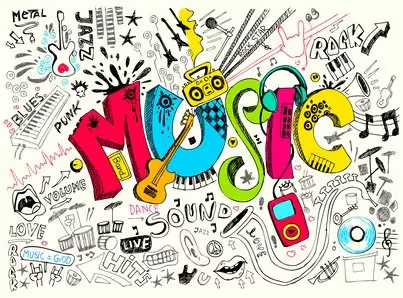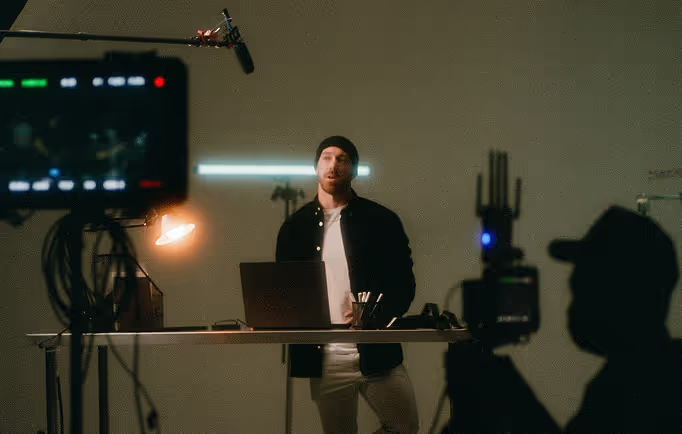5 ways to make music work for your animated video

Music is undoubtedly one of the most pervasive creative forces in our lives. Jump on any bus or train and you’ll find a handful of passengers sporting headphones. Walk through any shopping centre and you’ll hear a bland fusion of unthreatening pop tunes coming from every different supermarket, jeans store and $2 shop where they sell those plaster figurines of budgies and Chinese dragons.
With this complete social swamping of music, it can be difficult to know how to handle the beast of a billion Supre stores in your own creative or corporate videos. Animation has an especially strong reliance on audio, both music and foley, as a storytelling aid to accompany the animated visuals. So how can you put music to the best use in your animated video?
1. aim for invisibility
Think about the last video advertisement you saw. Can you remember in any detail what the music was like? If it was a good ad, probably not.
While listening to a highly catchy, lyrical song on your headphones with your eyes closed might be an affecting experience, this is what we call active listening. Active listening essentially sees your brain going, “Hey buddy, you really need to pay attention to these fancy chord progressions and heartfelt lyrics. None of that multitasking crap for you sir—you have music to concentrate on and emotions to feel.”
However, when we’re consuming visual media, especially corporate or educational videos with a strong point to relay, we require the audio to function as an invisible accessory to the message. In other words, we want to activate passive listening—the kind of listening that occurs when you’re working on an assignment with music playing in the background. Music that allows for passive listening lets us focus on the visual content while subconsciously absorbing the mood of the audio.
This is why so few corporate explainer videos have music with lyrics. It’s difficult to focus on a message or a set of instructions when a singer is warbling about something else entirely. This doesn’t mean you have to choose completely passive elevator music for your corporate video, but if the music is stealing focus from the content of your message, you may want to consider if it’s really the best choice for your video.
2. set a mood
What do you want your audience to take away from your video?
Do you want them to feel excited, safe, intrigued, moved to tears, in professional hands, angered into action, afraid of what will happen if they miss out on the fabulous opportunities your video is offering? The music you choose for your video can (and probably will) have a powerful impact on the mood your audience leaves with.
Like any creative art, there are no concrete rules on what kinds of music will evoke what emotion, because music doesn’t exist in a vacuum. Context plays a huge role in how the music will be received (more on that soon with point 3), but here are a few common guidelines you can follow:
Heavy percussive beats will generally come off as edgy or aggressive. Useful for an upbeat, youth-focussed target, not so useful for a video advertising a yoga studio. Unless it’s Extreme Yoga, involving skydiving where you have to perform downward-facing dog before your parachute is releas—you know what? Never mind.
Bouncy guitars or ukeleles in a major key evoke a sense of warmth and simplicity. Oh, you want a product that’s easy to understand and has that ol’ fashioned, home-grown sentiment attached to it? Let my sweet ukelele backing music tell you all about the grassroots product we have to offer. Great if your target market is yuppie pseudo hipsters buying gluten-free lemonade. Probably terrible for a tattoo parlour servicing a target market of hardcore punk and metal-heads. Unless you’re going for that ol’ fashioned, home-grown tattoo feel, just like grandma used to make.
Smooth lounge music is suitable for modern furniture, showrooms and cutting edge products of a non-technological nature. Also, waiting rooms.
Building the instrumentation throughout the video helps build emotional tension. If your video is telling an epic story, a common dynamic structure for the music would be to begin quietly, build gradually, then at the three-quarter mark pull right back to the quietest stage, before all instruments kick back in for the last leg, where the emotional release is. This can get cheesy when overused though, which brings us nicely to the next point:
3. … but don’t tell the audience how to feel
Heavy-handed use of music to push an emotion can kill the sincerity of your video. This comes back to the creative principle of ‘show, don’t tell’. Have you ever watched a movie with a friend who felt the need to point out every two minutes, “Ooh, I bet he’s a baddie,” or “No, don’t go in there!”, or “Gee, I hope the two protagonists who bicker all the time in between staring longingly at each other end up together. That would be so sweet. Wouldn’t that be sweet? So sweet.”
Your annoying friend is music.
Overbearing music, to be precise, who you just want to punch in the face because, yes, I can see the unexpected death of the protagonist’s wise old mentor is supposed to be sad, and I don’t need your woefully loud violins wailing at me in a minor key, “THIS IS A SAD SCENE. COMMENCE BEING SAD NOW.” If your visual content is effectively displaying the desired emotion, don’t smack the audience over the head with overly emotional music.
To add a sardonic twist, think about utilising a musical style contrary to the mood of your visual content. An example of this technique working for comedic effect can be seen in the TV series It’s Always Sunny in Philadelphia, where the antics of a selfish group of friends doing unethical and destructive things for money or fame is accompanied by a Doris Day style soundtrack, creating an oddly hilarious mix of bright optimism and cynical disenchantment.
4. not everyone likes everything
Case in point: for the life of me, I cannot understand the appeal of Lorde’s music. I’m sure she’s a wonderful person in real life, and she certainly has good vocal ability, but I find the songs themselves repetitive, texturally lacking, and frankly, boring. But, in amongst a sea people from the same demographic as me who LOVE her music, my opinion doesn’t matter one bit. Why? Because record executives are aware that you can’t please everyone.
In the same way, the musical choices in your video are bound to turn some people off. From a business standpoint, the best you can hope for is to appeal to a majority of your market.
This requires looking into the market research you did to develop the product, company or ideal your video is promoting. Who is your target audience? And based on those demographics, what kind of music are they likely to respond to? Try to aim for something that won’t repulse any secondary markets you may have, but in general focus on your target’s likes and desires.
I’m not telling you anything you don’t already know from basic marketing logic, just putting out a reminder that every part of your video needs to work together cohesively to project your message and to appeal to your target audience, and that includes the music. Which brings us to the last and most important point:
5. good music won’t save a bad story
We all know it, we’ve all heard it a billion times before, and yet in the grips of an animation or film project with a tight deadline that’s going a little off-the-rails in the story department, it’s far too easy to flippantly throw out the line, “We’ll just cover it with music.” That’s the equivalent of saying “We’ll fix it in post,” when all you have on film are blurry, badly composed shots. You’re not going to be fixing out-of-focus footage in post, just like you’re not going to be fixing a poorly focussed script with music.
The only possible exception that comes to mind is music videos, where the music is the primary product and the video is often a compulsory accessory. Even so, a bad music video is only going to debilitate the image of the music itself. At best, people will ignore the video and you’ll have wasted your money and time producing it. At worst, the video will ward off potential listeners and lose current ones for good.
conclusion
Most of these guidelines come back to the concept stated earlier: where film and animation are concerned, audio and video do not exist in a vacuum. To many people, a product is only as good as its weakest point. This is why it’s so important to gain a cohesive synergy between music and visuals in creating a video that will appeal to the widest possible audience.
Start a






